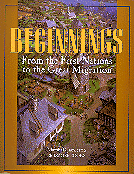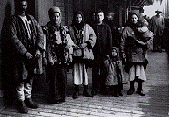


|
Beginnings: From the First Nations to the Great Migration.
Marshall Jamieson. Subject Headings:
Grades 6 - 9 / Ages 11 - 14. ***/4
|

excerpt:
"In May 1611, the explorer Samuel de Champlain visited the future site of Montreal. Champlain was an adventurous young man from France who had already travelled much of the world. He had come to Canada across the Atlantic Ocean on a sailing ship. Another French explorer, Jacques Cartier, had also visited the same site, about 75 years before. In his diary, Cartier had described a large First Nations village there, called Hochelaga. Now, there was no sign of the village or of the people who had once lived there. No one to this day knows what happened to the people of Hochelaga." (p.3)
The sense of history as an exciting mystery rather than a dry list of dates is evident right from the beginning of this wonderful history text aimed at students from approximately Grade 6 to 9. In a format similar to that used in his previous textbook, Alberta; A Story of the Province and its People (Reidmore Books, 1993), Marshall Jamieson pursues his treatment of Canadian history, concentrating this time on Canada as a country of immigrants, from the First Nations to the European settlers of the "Great Migration" in the nineteenth century.

There is extensive consideration of contacts between the First Nations and the Europeans: the hostility between the First Nations and the Norse, the importance of the fur trade, the role of diseases brought over from Europe. The text does a very good job of exposing the diversity of the First Nations
peoples, although the table on "The First Nations of Early Canada"
(p. 22-3) specifying the characteristics of the various groups
tends to be reductive, especially the section on "Beliefs".
Key events in Canadian history: the settlement of New France, the
deportation of the Acadians, the impact of the Loyalist migration,
the 1837 Patriot Rebellion of Lower Canada, the massive wave of
immigrants from Europe in the nineteenth century, are all treated
succinctly and effectively.
The author has done an excellent job of relating yesterday's history to today's controversy. It's intriguing, for example, to see the Loyalists represented as the first in a long line of refugees to Canada. This textbook is beautifully designed to attract the students' attention and to enhance learning.

Each chapter begins with a "Key to Understanding", a brief summary of its main points. Rather than presenting a solid block of information, the chapters are broken up into shorter narratives on political and social history,
biographical portraits (including those of Jeanne Mance, Henry VIII, Kelsey and Molly Brant), and historical documents such as letters and travel narratives. Occasionally, Jamieson uses chronologies to focus attention on important dates.
The textbook is also commendable for its inclusion of the often forgotten voices of women and of visible minorities, notably the Black Loyalists. A
section entitled "Points of View" encourages students to reconstruct historical conflicts imaginatively, especially through role play. The effect of the appealing illustrations, including maps, drawings, portraits, paintings, and photographs, is reinforced by questions listed under "Map Study" and "Picture
Study".
Each chapter concludes with a series of questions labelled "Looking Back", reminding the students of people and places to remember as well as outlining useful assignments for further research or analysis. The final chapter provides more review questions and invites students to reflect on the implications of diversity for Canadian culture. A glossary and an index complete the book.
Although I would highly recommend this textbook, I do have a few criticisms. First, the language is sometimes overly simplified, as in the following quotation:
"Unfortunately, we have no idea of what the First Nations thought of the Norse. Since they attacked the Norse, we can guess that they were not happy that the newcomers invaded their land." (p. 27).
Secondly, in terms of historical material, certain additions could be made. For example, when presenting the Patriot Rebellion of 1837, Jamieson might have reduced some of the distance between our two solitudes by mentioning the 1837 Upper Canada Rebellion. Also, a subsequent edition might correct the comment that in Lower Canada, "only well-to-do men, mainly those who owned property,
could vote" (p. 111). In Histoire des femmes au Quèbec depuis quatre siècles (Montréal: Le Jour, rev. ed., 1992), the Collectif Clio points out that from 1791 up until 1849, when they were specifically disenfranchised, women of Lower Canada who owned property also had the right to vote. These minor flaws do not, however, detract from the textbook's overall appeal and its usefulness in the classroom.
Highly Recommended
Kathleen Kellett-Betsos is an assistant professor in the French Department of Ryerson Polytechnic University in Toronto, Ontario.

To comment on this title or this review, send mail to cm@umanitoba.ca.
Copyright © 1996 the Manitoba Library Association. Reproduction for personal use is permitted only if this copyright notice is maintained. Any other reproduction is prohibited without permission.
Published by
The Manitoba Library Association
ISSN 1201-9364
AUTHORS |
TITLES |
MEDIA REVIEWS |
BOOKSHELF
BACK ISSUES |
SEARCH |
HOME